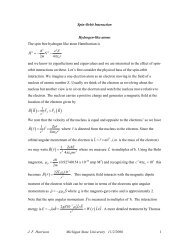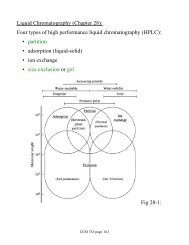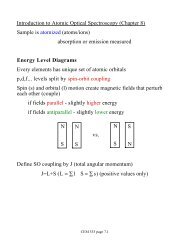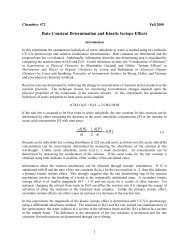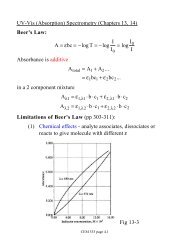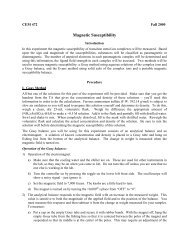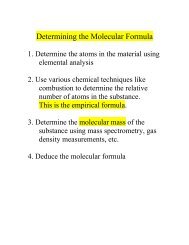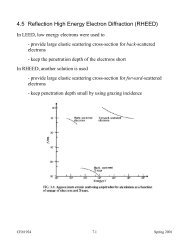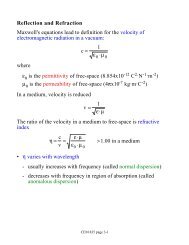SERS Surface Enhanced Raman Spectroscopy
SERS Surface Enhanced Raman Spectroscopy
SERS Surface Enhanced Raman Spectroscopy
- No tags were found...
You also want an ePaper? Increase the reach of your titles
YUMPU automatically turns print PDFs into web optimized ePapers that Google loves.
<strong>SERS</strong><strong>Surface</strong> <strong>Enhanced</strong> <strong>Raman</strong> <strong>Spectroscopy</strong>Christine J HicksSpring 2001MSU CEM 924
2Figure 1 shows silver roughness features on a silver surface. The metal surface can be roughened using oneof several methods. The roughness features are on the order of tens of nanometers; small, compared to thewavelength of the incident excitation radiation. 10, 13 The small size of the particles allows the excitation of the metalparticle’s surface plasmon to be localized on the particle. The resultant electromagnetic energy density on theparticle is the source of the EME mechanism and the primary contributor to the enhancement observed in <strong>SERS</strong>.The EME Mechanism and <strong>Surface</strong> Roughness FeaturesThe greater part of the overall enhancement of <strong>SERS</strong> is due to an electromagnetic enhancement mechanism that isa direct consequence of the presence of metal roughness features at the metal surface. These features can bedeveloped in a number of ways; for example: oxidation-reduction cycles on electrode surfaces; vapor deposition ofmetal particles onto substrate; metal spheroid assemblies produced via lithography; metal colloids; and, metaldeposition over a deposition mask of polystyrene nanospheres. 6,10 All of these methods leave the metal surfacewith small metal particles or aggregates of particles that are capable of serving as metal roughness features.The intensity of the <strong>Raman</strong> scattered radiation is proportional to the square of the magnitude of anyelectromagnetic (em) fields incident on the analyte.ΙR α E 2where ΙR is the intensity of the <strong>Raman</strong> field, and E is the total em fields coupling with the analyte; and whereE = Ea + Epfor which Ea is the em field on the analyte in the absence of any roughness featuresand Ep is the em field emitted from the particulate metal roughness feature. 5,10Of course, the em field of the excitation radiation is incident on the analyte. This is the case for normal <strong>Raman</strong>scattering and the Ea is relatively small since the source of the em radiation is relatively far away (the laser). This isone of the reasons why RS is a spectroscopy with notoriously weak signal. However, in <strong>SERS</strong>, the presence of theroughness feature provides another em field, that of the metal particle itself, Ep, and this em field is quite proximateas the analyte is adsorbed onto the roughness feature, of which the surface is composed. Because of thisproximity, any em field from the particle will contribute a large factor to E. The magnitude of the em field of theparticle is, thus, crucial to the intensity of <strong>Raman</strong> signal. Since the surface electrons of the metal are confined tothe particle whose size is small, the plasmon’s excitation is also confined to the roughness feature. The resultingem field of the plasmon is very intense. 10 The largeem energy density on the particle effects the ΙR ofthe scatterer as shown in the above relationships.
3It follows, too, that the analyte adsorbed between two <strong>SERS</strong>-active particles will be further enhanced than the(A)analyte proximate to only one such particle. 8OptimizationSince the roughness features are so important to <strong>SERS</strong>, much attention has been given to their study. Normalroughening procedures produce heterogeneous surfaces where the particles have a variety of sizes, shapes, andorientations. 4 The frequency of incident light that is effective in producing the intense em field on the particle isdependent on these characteristics of the roughness features as well as on the type of metal used. The orientationand shape characteristics of the particle certainly effect the optimal excitation frequency, as is evident within certainelaborate calculations that won’t be presented here. 10 Simply put, the EME is strongest where the particle has thehighest curvature; thus the adsorption of the analyte on the long or narrow axis of an ellipsoid or spheroid effectsthe magnitude of the <strong>SERS</strong> enhancement. 6,10Emory, et al. recently examined the optical enhancement of differently sized silver particles on the <strong>SERS</strong>spectra of Rhodamine 6G. They used Atomic Force Microscopy (AFM) to determine the size of the particlesprimarily responsible for the analyte’s signal enhancement; these particles are often called ‘hot particles’. Silverparticles responsive to three excitation wavelengths (488 nm, 568 nm, and 647nm) were scanned and found tohave an average diameter of 70±6nm, 140±9nm, and 190-200±20nm, respectively. 4 This work confirms that thesize of the particle effects the optimal excitation frequency and it can be inferred that the presence of aheterogeneously roughened surface reduces the efficiency of the SE since there would be only a fraction ofavailable particles whose enhancement abilities were optimized at any given excitation energy. 4,8 Jensen, et al.found that the optimal excitation wavelength changes for particles of varying heights (Figure 2), even when thediameter of the particle was kept constant. The value of D for Figure 2 is the diameter of thepolystyreneFigure 2: UV-vis extinction spectra for Ag nanoparticlesarrays on glass. All spectra have a constant in-plane widthproduced from a nanosphere deposition mask with D = 310nm (a = 90 ± 6 nm). Out-of-plane height, b, was varied.(A) b = 58 nm; _ max = 501 nm. (B) b = 53 nm;_max = 517 nm. (C) b = 43 nm; _max = 533nm. (D) b = 38 nm; _ max = 544 nm. (E) b = 33nm; _ max = 563 nm. (F) b = 23 nm; _max =585 nm.From Jensen, et al. J. Phys. Chem. B 2000, 104, 10549 –10556.
4(B)nanosphere used to create the deposition mask (vida infra); the value of a is the in-plane diameter of the depositedsilver particles; the value of b, the out-of-plane diameter was changed and the absorption spectrum taken todetermine the optimal excitation _.While the observations of Emory’s and Jensen’s groups are interesting in themselves, most significant is thedevelopment by Jensen and Van Duyne, et al of a controllable, predictable, and thus, reproducible, metal particledeposition scheme which allows tunability of the roughness features to a desired excitation wavelength. 6Irreproducibility of <strong>SERS</strong>-active substrates is a major limitation to the general analytical applicability of <strong>SERS</strong> andthis work suggests an end to that limitation. 8Jensen, et al used surfaces of mica or glass onto which was deposited a monolayer of polystyrenenanospheres. The nanospheres are of a single uniform size and self-associateinto two-dimensional hexagonal array (see Fig 3). Silver is then deposited over the nanospheres, resulting in<strong>SERS</strong>-active metal particles of uniform geometry and morphology. 6 As with any analytical technique, attempts tooptimize the system were made. With <strong>SERS</strong>, the incident light energy can be chosen such that it optimizesexcitation of both the analyte and the particle plasmon, resulting in improved coupling between their em fields. It isevident in the literature that any Resonance <strong>Raman</strong> <strong>Spectroscopy</strong> (RRS) enhancement is in addition to theenhancements of <strong>SERS</strong> since molecules that exhibit <strong>SERS</strong> can be further enhanced by use of a laser frequencyproviding RRS enhancements. 12 <strong>Surface</strong> <strong>Enhanced</strong> Resonance <strong>Raman</strong> <strong>Spectroscopy</strong> (SERRS) can beaccomplished by choosing the excitation wavelength such that it interacts with the stable excited electronic state ofthe analyte molecule and combining the RRS effect with a <strong>SERS</strong> active substrate. 2,8Other Enhancement EffectsWhile the EME is the primary contributor to the <strong>SERS</strong> enhancement, other mechanisms cannot be neglected for athorough understanding of <strong>SERS</strong>.Another electromagnetic effect arises from flat, as well as from roughened surfaces. The em field of theincident radiation couples with the analyte. In addition, that same field is reflectedby the surface of the metal and the reflection couples with the analyte, resulting in afour-fold enhancement of the single analyte’s scattered signal. Another four-foldenhancement occurs when the scattered field is reflected by the surface, for atotal theoretical reflectant enhancement of sixteen-fold. This translates into anexperimentally observed four- to six-fold enhancement that can be attributed to
5this mechanism. 5,10The chemical enhancement (CE) mechanism provides an order or two of magnitude enhancement to the<strong>Raman</strong> signal intensity. 7 It is less understood than the EME enhancement, but brings some interestingconsiderations to a thorough discussion of <strong>SERS</strong>. The molecule adsorbed onto the surface necessarily interactswith the surface. CE exists because of this interaction, which has been described in several ways. The metaladsorbateproximity may allow pathways of electronic coupling from which novel charge-transfer intermediatesemerge that have higher <strong>Raman</strong> scattering cross-sections than does the analyte when not adsorbed onto thesurface. 8 This is very much like a Resonance <strong>Raman</strong> effect. Another explanation is that the molecular orbitals ofthe adsorbate broaden into the conducting electrons of the metal, altering the analyte’s chemistry 2 . It is interestingto note that the CE effect may be an alteration in the scattering cross-section; the chemical nature of the analytechanging due to its interaction with the metal, whereas the EME effect was a change in the intensity of thoseanalyte molecules that did scatter, not a change in scattering cross-section.EM enhancements are apparently, and should be, chemically non-selective; that is, providing the sameenhancement for different analyte molecules adsorbed onto the same type of metal surface. However, N2 and COenhancements differ by a factor of 200. This is evidence for mechanisms other than the EME, and the CE isimplicated since the polarizabilities of the two molecules are almost the same, and orientation differences ofadsorption couldn’t account for a surface enhancement difference of such magnitude. 2Study of the CE is difficult because most studied surfaces are roughened and the EME and CE effects can’t beseparated. However, Campion, et al studied pyromellitic dianhydride (PMDA) adsorbed onto an atomically flatCu(111) surface. The surface’s electromagnetic contributions are small and well understood, making it easier toanalyze the CE mechanism. An enhancement of 30x was detected, and described as a Resonance <strong>Raman</strong> typephenomenon. Mechanisms other than the CE were carefully ruled out. 1UltrasensitivityOnly 1 in 10 11 analyte molecules inelastically scatter in <strong>Raman</strong> <strong>Spectroscopy</strong>. 12 As was pointed out above, theintensity of <strong>Raman</strong> signal from a scattering molecule is greatly enhanced under <strong>SERS</strong> conditions. This suggeststhat low concentrations of <strong>Raman</strong>-active analyte could be detected using <strong>SERS</strong> substrates. Analyte signal hasbeen acquired via <strong>SERS</strong> for concentrations as low as pico- and femto-molar. 5,8A typical technique for impurity detection is fluorescence spectroscopy (FS). But since FS doesn’t providestructural information, it would be helpful to scientists to not only be able to detect, but to identify the molecule andperhaps monitor structural changes. FS has cross-section as good as 10 -16 cm 2 / molecule. RS scattering crosssectionsare as poor as 10 -30 – 10 -25 cm 2 / molecule with the higher values for quite favorable RRS systems.
6Effective <strong>SERS</strong> cross-sections, however, can be as good as ~10 -18 cm 2 / molecule for Rhodamine 6G and similardyes. The theoretical estimates for the needed cross-section for single molecule detection using <strong>SERS</strong> is 4 x 10 –18cm 2 / molecule.It is interesting to note analyte aggregation inhibits the effectiveness of <strong>SERS</strong>. That is, the most effective andreproducible <strong>SERS</strong> spectra occur for analytes of concentrations about equal to the concentration of metal particlesites. 8 <strong>SERS</strong> has the potential to combine the structural information provided by RS with the sensitivity typicallyseen in fluorescence spectroscopy.Overlayer TechniquesThe distance dependence of <strong>SERS</strong> is utilized in the overlayer technique, wherein an ultrathin film of solid orliquid is adsorbed onto the <strong>SERS</strong>-active substrate and the analyte within the film can borrow the EME of thesubstrate and have its <strong>Raman</strong> spectra greatly enhanced. This makes <strong>SERS</strong> applicable to organic films,semiconductors, insulators, etc. 14 Spacer layers can be adsorbed onto the substrate, and can alter the chemistry ofeither the substrate or overlayer, increasing the utility of <strong>SERS</strong> still further. An advantage to the overlayertechnique is that it diminishes the inhibiting effect of metal surface defects, such as pinholes in silver. 14,15Since the primary enhancement in <strong>SERS</strong> is due to an electromagnetic effect and any em field decreases instrength with distance from the point source, it follows that an analyte could benefit from the enhancement of a<strong>SERS</strong>-active substrate even if that analyte were some distance away from the enhancing surface. Theoreticalcalculations have been conducted, and the <strong>SERS</strong> enhancement, G, has been found to scale with distanceaccording toG = [ r / ( r + d ) ] 12where r is the radius of the spherical metal roughness feature and d is the distance of the analyte to that feature.Experimentally, the enhancement decreases ten-fold with a distance of 2-3 nm; a distance of 20-30 Å, or amonolayer or two. 2,8,14The transition metals do not typically give good <strong>SERS</strong> spectra, but Pd, Pt, Rh, and Ir, are useful in catalyticsystems, so it would be helpful to optimize these metals for <strong>SERS</strong>. Zou, et al. make use of the distancedependence of <strong>SERS</strong> by laying transition metals over a <strong>SERS</strong> active substrate, so that studies at the transitionmetal surface can be conducted with the analytes or transition metal benefiting from the enhancement of theunderlying <strong>SERS</strong> substrate. This approach also minimizes the ‘pinhole’ problem common in gold; that is, surfacedefects can greatly alter <strong>SERS</strong> efficiency and analyte adsorption thermodynamics. Deposition of a few ultrathinlayers of metal onto the gold removes the effects of the pinhole sites.
7Temperature Dependence and Time Resolution ApplicationsIn considering <strong>SERS</strong> as an analytical technique for studying catalytic systems, the effects of temperature on <strong>SERS</strong>is of interest. Pang, et al. discuss the reversible temperature dependence observed for 1-propanethiol on silverfilms. Their control experiments ruled out incidences of thermal desorption, contaminant evaporation, and thermal<strong>Raman</strong> shifts, leaving only an electromagnetic mechanism for <strong>SERS</strong>. Thermal desportionof the adsorbate at hightemperatures was an inadequate explanation for the temperature dependence because of the experimentalconditions. Contaminant evaporation was an inadequate explanation because the temperature dependence wassmooth, rather than abrupt (the way it would appear if contaminants were to suddenly evaporate from the surface).Thermal population of vibrational states was discounted as well, leaving only the EM model to explain thetemperature dependence. They then present equations to demonstrate that the temperature dependence weakensas the aspect ratio of the <strong>SERS</strong>-active particle deviates from the optimum values. 10Chiang, et al. elaborated on the work of Pang, et al, pointing out that there is a temperature dependence for thevibration of the surface plasmon, which of course affects the incident radiation frequency dependence of the <strong>SERS</strong>substrate change. 3 This means that optimization of the incident laser radiation would need to include aconsideration of temperature, as well as analyte, metal, and roughness feature characteristics.As an example of the utility of <strong>SERS</strong> for studying biological systems, consider the work of Lecomte et al. Thestructural dynamics of the biological electron transport heme proteins have been studied. The <strong>SERS</strong> spectra wereresolved to the picosecond time scale, and provided information regarding the structural changes of the speciesinvolved in the charge transfer process.SummaryThe limitations of normal RS effect <strong>SERS</strong>, as well, in that the analyte must still be <strong>Raman</strong> active. <strong>SERS</strong> has its ownunique limitations. Many of these are due to the difficulty of obtaining reproducible <strong>SERS</strong>-active substrates. Withthe work of Jensen and Van Duyne, however, this limitation is likely to become less restricting. There may alwaysbe, however, the problem of the thermodynamics of analyte adsorption to the surface of interest. It may be difficultto obtain calibration curves for single analytes, and moreso for complex mixtures. 8 Also, the <strong>SERS</strong> spectra may notbe as compound-unique as scientists might like. Nevertheless, complex mixtures and trace analysis can beaccomplished.
8LITERATURE1. Campion, A; Ivanecky III, J.E; Child, C.M. and Foster, M. J. Am. Chem. Soc. 1995, 177, 11807-118082. Campion, A. and Kambhampati, P. Chem. Soc. Rev. 1998, 27, 241-2503. Chiang, H.-P.; Leung, P.T.; and Tse, W.S. J. Phys. Chem. B 2000, 2348-23504. Emory, S.R.; Haskins, W.E.; and Nie, S. J. Am. Chem. Soc. 1998, 120, 8009-80105. Garrell, R.L. Anal. Chem. 1989, 61, 401A- 411A6. Jensen, T.R.; Malinsky, M.D.; Haynes, C.L.; and Van Duyne, R.P. J. Phys. Chem. B 2000, 104,10549 –105567. Kambhampati, P.; Child, C.M.; Foster, M.C.; and Campion, A. J. Chem. Phys. 1998, 108, 5013-50268. Kneipp, K.; Kneipp, H.; Itzkan, I.; Dasar, R.R.; and Feld, M.S. Chem. Rev. 1999, 99, 2957-29759. Lecomte, S.; Wackerbart, H.; Soulimane, T.; Buse, G.; and Hildebrandt, P. J. Am. Chem. Soc.1998, 120, 7381-738210. Moskovits, M. Rev. Mod. Phys. 1985, 57, 783.11. Pang, Y.S.; Hwang, J.H.; and Kim, M.S. J. Phys. Chem. B 1998, 102, 7203-7209.12. Pemble, M.E. “Vibrational <strong>Spectroscopy</strong> from <strong>Surface</strong>s.” <strong>Surface</strong> Analysis – The PrincipleTechniques Ed. Vickerman, J.C. Chichester, England: John Wiley & Sons, 1997. 299-30413. Weaver, G.C. and Norrod, K. J. Chem. Ed. 1998, 75, 621-624.14. Weaver, M.J.; Zou, S.; Chan, H.Y.H. Anal. Chem. 2000, 72, 38A-47A15. Zou, S.; Williams, C.T.; Chen, E. K.-Y.; and Weaver, M.J. J. Phys. Chem. B 1998, 102, 9039-9049.Acknowledgments:My thanks to Jason Stotter, Sandra Bencic, Dr. Scott Goldie, and Jaycoda Major for their comments.



